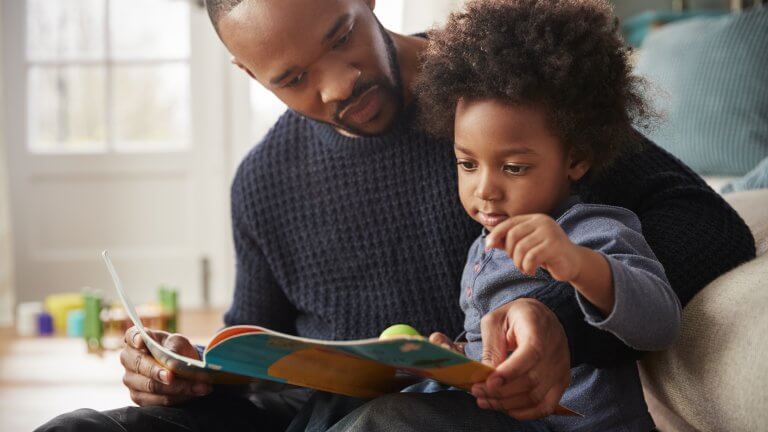Engaging your preschool child in learning activities at home isn’t as challenging as it might seem. In fact, if you ask an early childhood educator what they enjoy most about teaching young children, many say that they absolutely love how curious this age group is about the world around them. It’s true! If you’ve ever spent time with a young learner, their enthusiasm is contagious and it’s evident that learning can happen anywhere and anytime. Education doesn’t happen strictly within the confines of the classroom. Yes, kids learn about the world around them through their teachers, but they also learn through their families and caregivers. Even when school isn’t in session, families can provide their young children with rich learning experiences centered around many “every day” activities if they have a few simple strategies in their toolbox.
Let’s take a look at 5 ideas for engaging preschool children outside of the classroom.
- Watching TV
- Going on a Walk
- Preparing Food
- Reading a Book
- Singing Songs
#1 Watching TV
Are we encouraging families to spend all day in front of the screen with young children? No. However, we recognize that screen time is a part of the day for most kiddos. With a few simple understandings, families can make this time meaningful and use it as an opportunity for engaging your preschool child.
Research has shown that screen time benefits young children the most when families ask and answer questions during a program and have rich conversations about what they’re watching together. In other words, whenever parents engage with their kids, it’s beneficial. For example, TV can help young children learn about a variety of subjects and concepts. Kids get to explore subjects, places and animals that they might not have access to otherwise. TV can also inspire “unplugged” play after the program is finished. If a child watches a show about a trip to a farm, maybe the child pretends to be a farmer and take care of animals after the show. Finally, TV can provide models for positive agendas such as healthy living or taking care of the environment. If parents are intentional about the programs they choose and how they interact with their child while watching TV, screen time becomes an active, rather than passive, activity.
#2 Going on a Walk
When young children don’t have access to a playground, public pool, or backyard, it might feel pointless to venture outside. Yet, for young children, even a walk down the street or around the block can be an adventure! There are so many ways to embed learning when taking a walk with little ones. Families and caregivers can work on colors, language, creative expression, literacy, science, math, and more!
One method of engaging your preschool child when taking a walk is to point at and label objects, plants, and animals or you can play “I Spy.” This will help young children increase listening skills and develop vocabulary. Talking about the weather outside addresses science concepts. A scavenger hunt can connect to math by counting found objects. Taking photographs of interesting flowers, bugs and birds gives kids opportunities for creative expression and can link to literacy when the photographs are printed and made into a homemade book. When you take a walk with a young child, there’s always something to discover!
#3 Preparing Food
Cooking in the kitchen with little ones can feel overwhelming, right? With all of the knives, the hot surfaces, and the mess, it can feel like a recipe for disaster! However, families shouldn’t throw in the towel without considering the benefits to inviting young children into the kitchen. Preparing food with little ones provides naturally occurring opportunities to work on fine motor skills, cognitive skills, social skills, and academic areas such as math and science. And what’s even more exciting is that parents can include young children in the kitchen without even turning on the oven!
When including young children in food preparation activities, parents might consider assigning age appropriate or ‘bite sized’ kitchen tasks such as mixing, pouring, putting groceries away, or tearing lettuce for a salad. Appointing a child as ‘official taster’ for whatever is being prepared can be fun for them and may broaden their palate. Consider also that children don’t need to complete an entire task. They can do part of a task, such as laying out bread slices for sandwiches, or using cookie cutters on dough that has been rolled out for them. If it’s safe and appropriate for children to help with cutting, there are nylon safety knives that cut vegetables, but not skin. Finally, even if young children aren’t ready to be a chef’s assistant, inviting them to sit on the kitchen floor and explore different cooking equipment like pots, pans and safe utensils builds fine motor skills and is fun for them, too!
#4 Reading a Book
One of the best ways that families can connect with their children at home is through reading books. Many parents have reading “routines” with their young children, such as snuggling up with a book before rest time or bedtime. These routines and rituals not only provide comfort and connection, but also provide opportunities to embed some foundational literacy skills.
According to emergent literacy expert, Dr. Laura Justice, there are 3 simple strategies that families can incorporate into their reading time which will set their kiddos up for later success in reading. Pointing at the print while reading is an easy way to help young children pay attention to different print types and functions. Asking questions that challenge young children to make predictions and connections to text builds reading comprehension skills that they will use for the rest of their lives. Finally, noticing interesting words while reading and giving “child friendly” definitions goes a long way in expanding a young child’s vocabulary and engaging your preschool child. Perhaps most importantly, reading every day with young children will start them on the path to developing a lifelong love of books!
#5 Singing Songs
Why is singing such a mainstay in early childhood classrooms? Besides the fact that singing and dancing are really fun, neurobiologists have found that music activities literally mold the mind by engaging brain synapses. Pretty cool, right? Whether or not a child is able to sing along or do all of the movements, music is powerful!
There are so many skills that children can develop through singing including motor skills, shapes and colors, letters and vocabulary, and more! A good thing to remember is that when children are young, participation in singing can look many different ways. Some children might dive right in with singing and moving and others might start out as “watchers.” It’s all good! Adding props, like a wooden spoon for a microphone, or homemade instruments like paper plate shakers can help children feel more included if they’re not ready or able to sing and move. When families pay attention to these strategies and considerations, engagement and fun are sure to follow!
View our whole free video series on Home Engagement tips for your preschool kids!
Jennifer Russell is an education specialist for the Early Childhood Special Education team here at the Education Service Center Region 13.






I’m homeschooling my 4 yr old non verbal autistic grandson because of virus. He will not stay still wants to bang on keys. I get frustrated and here we go. I need help. At school he is perfect
Thank you very much! This will be great for parents. Do you have this presentation in Spanish?
Yes! and thanks for asking. The videos have also been recorded in Spanish and can be found here:
https://fast.wistia.net/embed/channel/iq88dc5yvi